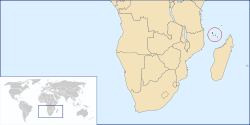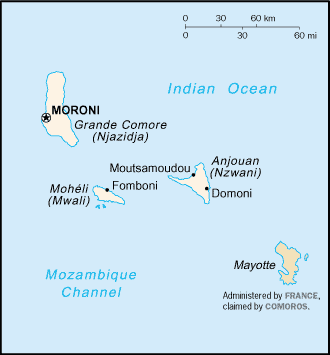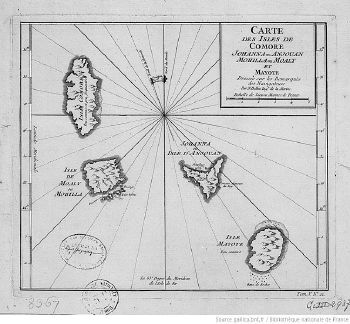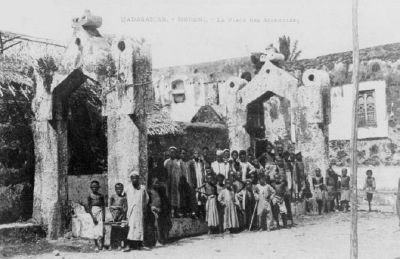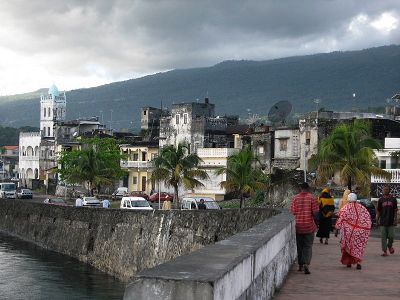Comoros
| Union des Comores Udzima wa Komori (Comorian) ōßŔĄōßō™ō≠ōßōĮ ōßŔĄŔāŔÖōĪŔä al-IttiŠł•ńĀd al-Qumurńę/Qamarńę Union of the Comoros |
||||||
|---|---|---|---|---|---|---|
|
||||||
| Motto:¬†"Unit√© ‚Äď Solidarit√© ‚Äď D√©veloppement"¬†(French) "Unity ‚Äď Solidarity ‚Äď Development" |
||||||
| Anthem: Udzima wa ya Masiwa (Comorian) "The Unity of the Great Islands" |
||||||
| Capital (and largest city) | Moroni 11¬į41‚Ä≤S 43¬į16‚Ä≤E | |||||
| Official languages | Comorian Arabic French |
|||||
| Demonym | Comoran(s)[1] | |||||
| Government | Federal republic | |||||
|  -  | President | Azali Assoumani | ||||
|  -  | President of the Assembly | Moustadroine Abdou | ||||
| Independence | ||||||
|  -  | from France | July 6, 1975  | ||||
| Area | ||||||
|  -  | Total | 2,235 km² (178th (incl. Mayotte)) 863 sq mi  |
||||
|  -  | Water (%) | negligible | ||||
| Population | ||||||
|  -  | 2023 estimate | 888,378[1] (164th) | ||||
|  -  | Density | 457/km² (27th) 1,184/sq mi |
||||
| GDP (PPP) | 2023 estimate | |||||
|  -  | Total | |||||
|  -  | Per capita | |||||
| GDP (nominal) | 2023 estimate | |||||
|  -  | Total | |||||
|  -  | Per capita | |||||
| Gini (2014) | 45.3[3] (141st) | |||||
| Currency | Comorian franc (KMF) |
|||||
| Time zone | EAT (UTC+3) | |||||
|  -  | Summer (DST) | not observed (UTC+3) | ||||
| Internet TLD | .km | |||||
| Calling code | [[++269]] | |||||
The Comoros (officially the Union of the Comoros) is an island nation in the Indian Ocean. The country consists of three islands in the volcanic Comoros archipelago: Njazidja, Mwali, and Nzwani. Comoros also lays claim to Mayotte (aka Mahoré), a neighboring island in the Comoro archipelago that remains a French Overseas Territory.
The Comoros is notable for its diverse culture and history, as a nation formed at the crossroads of many civilizations. It has three official languages‚ÄĒ Comorian (Shikomor), Arabic, and French. Its name derives from the Arabic word qamar ("moon"), as seen depicted on its flag. However it has had a troubled history since independence in 1975, with an inordinate number of coups.
At 2,235 km², the Comoros is the third smallest African nation by area and one of the smallest in the world; it has one of the highest population densities in Africa.
Geography
Comoros is located off the eastern coast of Africa on the northern end of the Mozambique Channel between northern Madagascar and northeastern Mozambique. The nearest countries are Mozambique, Tanzania, Madagascar, and the Seychelles. The area occupied by the Comoros Islands is slightly more than 12 times the size of Washington, D.C.
The islands: Njazidja (Grande Comore), Mwali (Moheli), Nzwani (Anjouan), and Maore (Mayotte) with their French names in parentheses, have distinct topographical characteristics due to their different ages. Maore, the oldest of the islands, is highly eroded with slow, meandering streams. Ngazidja, the youngest of the islands, is dominated by a massive, active volcano, that erupted as recently as 2005. Volcanic experts are concerned that a very violent eruption may occur in the near future. The other two islands are mountainous but have no active volcanic activity. The capital, Moroni, is on the western edge of Njazidja.
Flora and fauna
The mountainous terrain on several of the islands creates a variety of habitats with diverse animal and plant species, several of which are unique to the Comoros, such as Livingstone's fruit bat, the world's largest bat with a wing span that exceeds four feet.
Several different kinds of insects and over a dozen bird species are also unique to the islands, including Humboldt's flycatcher. Many are now being threatened with extinction.
In the waters around the islands lives the famous coelacanth, once thought by scientists to have been extinct for millions of years. But in the second half of the last century, an ichthyologist learned that Comorian fishermen regularly caught coelacanths in the deep waters surrounding the islands of Njazidja (Grande Comore) and Nzwani (Anjouan). Several specimens have since been preserved and can be seen today in museums around the world.
There is an abundance of life in the sea around the Comoros. One can find everything from giant whales, large sharks, big manta rays, sailfish, sunfish, to lobsters, crabs and tiny shrimp. Deep water close to the islands, coral reefs, miles of sandy beaches, plus fresh water streams and shoreline springs provide multiple habitats for marine life.
Climate
Located a little more than 10 degrees below the equator in the western Indian Ocean, the islands have a maritime tropical climate. In the wet season from October to April, the predominant northerly winds of the Indian Ocean bring moist, warm air to the region. Heaviest rainfall occurs from December to April and amounts can reach as high as 15 inches (390 mm) in a month. The mean temperature during the wet season is in the high seventies with the hottest month, March, averaging temperatures in the middle eighties (Fahrenheit). From May to September southerly winds dominate the region. These are cooler and drier, and temperatures in the islands average around 66 degrees Fahrenheit (19 degrees Celsius).
Rainfall and temperature vary from island to island during any month and even vary on an island due to the topography. The central, higher areas of an island are often cooler and more moist than the coastal regions. This variation results in microecologies on the islands, with distinct flora and fauna.
History
Pre-colonial inhabitation
The first human inhabitants of the Comoro Islands are thought to have been Polynesian and Melanesian settlers, Malays and Indonesians, traveling by boat. They settled in at least the sixth century C.E., the date of the earliest known archaeological site, found on Nzwani, and some sources speculate settlement as early as the first century. The islands of Comoros became populated by a succession of diverse groups from the coast of Africa, the Persian Gulf, Indonesia, and Madagascar. Settlers of the Swahili people first reached the islands as a part of the greater Bantu expansion that took place on the continent of Africa throughout the first millennium.
Development of the Comoros is divided into phases beginning with Swahili influence and settlement from the ninth to tenth centuries, in which the islands maintained only a single central village each. By the eleventh to the fifteenth centuries, trade with the island of Madagascar and Middle Eastern merchants flourished and smaller villages sprang up while towns grew. Contact with Middle Eastern merchants brought Islam to the islands for the first time, and it gained in popularity. Large mosques were soon constructed.
The Comoro Islands, like other coastal areas in the region, were important stops in early Islamic trade routes. Despite its distance from the coast, it is situated on the major sea route between Kilwa and Mozambique, which was an outlet for Zimbabwean gold. By the early seventeenth century, slaves had become Comoros' most important export commodity. Beginning in 1785, the Sakalava of the west coast of Madagascar began slaving raids on Comoros. Thousands of islanders were sold to work on sugar plantations in French-occupied Madagascar, Mauritius, or Reunion.
By the nineteenth century, Shirazi influence dominated the islands. Sunni Arabs from Shiraz, Iran, the Shirazi traded along the coast of East Africa as well as in the Middle East and India, and established colonies in the Comoros. Arab influence increased with the ascendancy of Zanzibar under Arab Omani rule, Comorian culture, especially architecture and religion, increasingly reflected Arab contact. Many rival sultanates were established in the sixteenth and seventeenth centuries.
French colonization
Portuguese explorers visited the archipelago in 1505. France first established colonial rule in the Comoros beginning in 1841. The first French colonists landed in Mayotte, and Andrian Tsouli, the king of Mayotte, signed the Treaty of April 1841, which ceded the island to French authorities. In 1886, Mohéli was turned over to French protection by its Queen Salimba Mochimba. That same year, after consolidating his authority over all of Grand Comore, Sultan Said Ali agreed to French protection of his island, though he retained sovereignty until 1909. Also in 1909, Sultan Said Muhamed of Anjouan abdicated in favor of French rule of the island.
The Comoros (or Les Comores) was officially made a French colony in 1912, and the islands were placed under the administration of the French colonial governor general of Madagascar in 1914.
The Comoros continued to be used as a way station for merchants to the Far East and India until the construction of the Suez Canal greatly reduced traffic passing through the Mozambique Channel. The only native commodities exported by the Comoros were coconuts. French settlers, French-owned companies, and wealthy Arab merchants established a plantation-based economy that now uses about one-third of the land for export crops. France converted Mayotte into a sugar plantation colony. The other islands were soon transformed as well, and the major crops of ylang-ylang (which produces an oil used in perfume), vanilla, coffee, cocoa, and sisal were introduced.[4]
Agreement was reached with France in 1973 for Comoros to become independent in 1978. On July 6, 1975, however, the Comorian parliament passed a resolution declaring independence. The deputies of Mayotte, which stayed under French control, abstained. Referendums on all four of the islands except Mayotte showed strong support for independence. Ahmed Abdallah became the first president and proclaimed the Comoros' independence on September 5, 1975. By staying part of France, Mayotte residents get free education, health care, and a minimum wage.
Independent Comoros
The next 30 years were a period of political turmoil. Since independence from France, the Comoros experienced more than 20 coups or attempted coups.[5]
It began in 1975 when mercenary Bob Denard, with clandestine funding by Jacques Foccart and the French government, removed President Ahmed Abdallah from office in an armed coup on August 3, 1975, and replaced him with United National Front of the Comoros (UNF) member Prince Said Mohammed Jaffar. Just a few months later, in January 1976, Jaffar was ousted in favor of Minister of Defense Ali Soilih.[6]
Around that time, in two referendums ‚ÄĒ December 1974 and February 1976 ‚ÄĒ the population of Mayotte voted against independence from France (by 63.8 percent and 99.4 percent, respectively). The three independent islands instituted a number of socialist and isolationist policies that soon strained relations with France.
In 1978, Denard returned and overthrew President Soilih by force and re-instated Abdallah with the support of the French and South African governments. Abdallah's presidency was marked by authoritarian rule and increased adherence to traditional Islam.[7]
Abdallah continued as president until 1989 when, fearing a probable coup d'état, he signed a decree ordering the Presidential Guard, led by Denard, to disarm the armed forces. Shortly thereafter, Abdallah was allegedly killed by a disgruntled military officer. Denard was evacuated to South Africa and Said Mohamed Djohar, Soilih's older half-brother, became president and served until September 1995 when Denard returned and attempted another coup. France intervened with paratroopers and forced Denard to surrender.[8][9] The French removed Djohar and Mohamed Taki Abdulkarim became president by election. He led the country from 1996 until he died in November 1998, a time of labor crises, government suppression, and secessionist conflicts. He was succeeded by interim President Tadjidine Ben Said Massounde.[10]
The islands of Anjouan and Mohéli had declared their independence from the Comoros in 1997, attempting to rejoin French rule. France, however, refused, and there were bloody confrontations between federal troops and rebels during Taki's government.
Col. Azali Assoumani, army chief of staff, seized power in a bloodless coup in April 1999, citing the interim president's weak leadership in the face of crisis. A subsequent failed attempt by Azali to consolidate power and reestablish control over the islands was the subject of international criticism, and the African Union, under the auspices of President Mbeki of South Africa, intervened, imposing sanctions on Anjouan to help broker negotiations and effect a reconciliation.[11][12] This involved a system of governmental autonomy for each island, plus a Union government for the three islands.
Azali stepped down in 2002 to run in the democratic election for president of the Comoro Union, which he won. Under international pressure as a military ruler who had originally come to power by force and was not always democratic while in office, Azali led the Union through constitutional changes that enabled new elections. A "Loi des compétences" (a law that defines the responsibilities of each governmental body) was passed in early 2005 and is in the process of implementation.
The elections in 2006 were won by Ahmed Abdallah Mohamed Sambi, a Sunni Muslim cleric nicknamed the "Ayatollah" for his time spent studying Islam in Iran. Azali honored the election results, thus allowing the first-ever peaceful and democratic exchange of power in the archipelagos' recent and turbulent history.[13]
In 2007, however, in voting for the presidencies of the three islands, Mohamed Bacar refused to relinquish his post and inaugurated himself for a second term as president of Anjouan Island, in defiance of the Union government.[14]
Following elections in late 2010, former Vice-president Ikililou Dhoinine was inaugurated as president on May 26,2011. Dhoinine is the first President of the Comoros from the island of Mwali. Following the 2016 elections, Azali Assoumani, from Ngazidja, became president for a third term. In 2018 Azali held a referendum on constitutional reform that would permit a president to serve two terms. The amendments passed, although the vote was widely contested and boycotted by the opposition, and in April 2019, and to widespread opposition, Azali was re-elected president to serve the first of potentially two five-year terms.
In 2021, Comoros signed and ratified the Treaty on the Prohibition of Nuclear Weapons, making it a nuclear-weapon-free state, and in 2023, Comoros was invited as a non-member guest to the G7 summit in Hiroshima.
Politics
Politics of the Union of the Comoros takes place in a framework of a federal presidential republic, whereby the president is both head of state and head of government, and of a pluriform multi-party system. The constitution was ratified by referendum on December 23, 2001, and the islands' constitutions and executives were elected in the following months. It had previously been considered a military dictatorship, and the transfer of power from Azali Assoumani to Ahmed Abdallah Mohamed Sambi in May 2006 was the first peaceful transfer in Comorian history.
Executive power is exercised by the government. Federal legislative power is vested in both the government and parliament. The preamble of the constitution guarantees an Islamic inspiration in governance, a commitment to human rights, and several specific enumerated rights, democracy, and "a common destiny" for all Comorians.
Typically, the president is to be elected by direct universal suffrage to a five-year term and is limited to two terms. Suffrage is extended to all citizens over the age of 18 who possess full civil and political rights. The president nominates ministers to form a cabinet called the Council of Government. If the presidency becomes vacant for any reason the president of the Supreme Court serves as interim president until an election can be held.
The legislature is bicameral. Assembly (lower house) representatives are elected to four-year terms through a popular vote. An electoral college chooses senators. The leader of the party with the most number of seats in the Assembly holds the post of prime minister.
Each of the islands has a great amount of autonomy in the Union, including having its own constitution (or Fundamental Law), president, and parliament. The presidency and Assembly of the Union are distinct from each of the islands' governments. The presidency of the Union rotates between the islands.[15] Anjouan holds the current presidency rotation, and so Ahmed Abdallah Mohamed Sambi is president of the Union; Mohéli and Njazidja follow in four-year terms.[16]
The Comorian legal system rests on Islamic law and an inherited French (Napoleonic code) legal code. Village elders or civilian courts settle most disputes. The judiciary is independent of the legislative and the executive.
The Supreme Court acts as a Constitutional Council in resolving constitutional questions and supervising presidential elections. It also arbitrates in cases where the government is accused of malpractice. The Supreme Court consists of two members selected by the president, two elected by the Federal Assembly, and one by the council of each island.[15]
Military
The military resources of the Comoros consist of a small standing army and a 500-member police force, as well as a 500-member defense force. A defense treaty with France provides naval resources for protection of territorial waters, training of Comorian military personnel, and air surveillance. France maintains a small troop presence in Comoros at government request as well as a small maritime base and a Foreign Legion Detachment on Mayotte.
Foreign relations
When Comoros became a member of the United Nations in 1975, the new nation was defined as consisting of the entire archipelago, although France maintains control over Mayotte. Comoros has repeatedly pressed its claim to Mayotte before the UN General Assembly, which has adopted a series of resolutions opining that Mayotte belongs to Comoros under the principle that the territorial integrity of colonial territories should be preserved upon independence. As a practical matter, however, these resolutions have little effect and there is no foreseeable likelihood that Mayotte will become part of Comoros without its people's consent. More recently, the Assembly has maintained this item on its agenda but deferred it from year to year without taking action.
Comoros is a member of the African Union, the Arab League, the European Development Fund, the World Bank, the International Monetary Fund, the Indian Ocean Commission, and the African Development Bank.
Economy
Comoros is one of the poorest countries in the world. Sixty percent of the population lives below the poverty line. Economic growth and poverty reduction are major priorities for the government. Unemployment is high. Agriculture, including fishing, hunting, and forestry, is the leading sector of the economy and the majority of the working population is employed in that sector. Yet most of the land is used for cash crops rather than food crops, and Comoros imports most of its food. Imports of rice, the main staple, account for 90 percent of all imports.
Comoros has an inadequate transportation system, a young and rapidly increasing population, and few natural resources. The low educational level of the labor force contributes to a subsistence level of economic activity, high unemployment, and a heavy dependence on foreign grants and technical assistance. Agriculture provides most of the exports. Comoros is the world's largest producer of ylang-ylang (whose essential oil is used in distilling perfumes) and the second-largest producer of vanilla. It is also a major exporter of cloves.
The government is struggling to upgrade education and technical training, privatize commercial and industrial enterprises, improve health services, diversify exports, promote tourism, and reduce the high population growth rate.
Remittances from Comorans living abroad are seen as a lifeline for impoverished communities at home, where there is little hope that the government will be able to meet their daily needs. With almost one-third of its population living outside the country - mainly in France - recent research has shown that, where the state has failed, contributions from the Comoran diaspora are playing a central role in providing basic services. In terms of its dependence on remittances per capita, the Indian Ocean archipelago ranks second after Eritrea in the African continent.
But World Bank researchers pointed out that a large portion of the financial contributions received from abroad went into "private consumption," with very little channeled towards savings and productive investments. Although remittances were also used to improve nutrition, shelter, education, and health, the survey highlighted that a substantial portion was spent on luxury goods unrelated to poverty reduction. One such "luxury" are grandiose wedding ceremonies, which are estimated to account for over half the expenditure of all remitted funds.
These wedding ceremonies are a series of elaborate rituals that involve an exchange of expensive gifts between the couple's families and feasts for an entire village. The cost of the ceremony can amount to between $20,000 and $60,000, raised primarily by pooling the remittances administered by community associations.
The Comoros claims the Banc du Geyser and the Glorioso Islands as part of its exclusive economic zone.
Demographics
With fewer than a million people, the Comoros is one of the least populous countries in the world but also one of the most densely populated, with an average of 275 people per km². Major urban centers include Moroni, Mutsamudu, Domoni, Fomboni, and Tsémbéhou.
The islands of the Comoros share mostly African-Arab origins. Sunni Islam is the dominant religion, representing as much as 98 percent of the population. Although Arab culture is firmly established throughout the archipelago, a minority of the citizens of Mayotte (the Mahorais) are Roman Catholic and have been strongly influenced by French culture. Malagasy and Indian minorities also exist, as well as Creole-speaking minorities mostly descended from Réunionnaise. Chinese peoples are also present on Mayotte and parts of Grande Comore (especially Moroni).
The islands are home to three living indigenous languages; also, four living non-indigenous languages are established within the country. French is the official language of the country.[17] The most common language is Comorian, or Shikomor, a descendant of Swahili with Arabic influences. Shingazidja, Shimwali, Shinzwani, and Shimaore are the local dialects spoken on each of the islands, Ngazidja, Mwali, Nzwani, and Mahoré, respectively. French and Arabic are also official languages, along with Comorian. Arabic is widely known as a second language, being the language of Qur'anic teaching, and French is the language of all other formal education. Malagasy is also spoken by a small number of Malagasy immigrants. Comorian has no native script, but both Arabic and Latin scripts have been used.
Culture
Islam helps to integrate Comoran society. As Sunni Muslims, the people follow religious observances conscientiously, and fundamentalism is on the rise, especially among the young who have studied abroad. Comoros' poverty and instability make it a fertile area to recruit adherents.
Most of the educated populace of the Comoros has attended Qur'anic schools at some point in their life, often before regular schooling, where boys and girls are taught and memorize the Qur'an and Arabic at early ages. Some parents specifically choose this early schooling to offset French schools that children usually attend later. Since independence and the ejection of French teachers, the education system has been plagued by poor teacher training and poor results, though recent stability may allow for substantial improvements.[18]
Marriage tends to be polygynous, but in a remnant of African matrilineal traditions, the husband moves into his wife's home, maintaining several households. Women are also able to own and inherit certain landholdings, another survivor of African customs.
Only by fulfilling the ritual grand marriage can a man be entitled to participate in his village's assembly of notables or get further involved in political life.
Music
Twarab music, imported from Zanzibar in the early twentieth century, remains the most influential genre on the islands and is popular at ada marriages. Sega music from nearby Mauritius and Réunion is also popular.
Comorian instruments include the 'oud and violin, the most frequent accompaniment for twarab, as well as gabusi (a type of lute) and ndzendze (a box zither), and the msondo drum. The primitive oboe, the ndzumara, is now nearly extinct.
Media
There are two daily national newspapers published in the Comoros, the government-owned Al-Watwan, and the privately owned La Gazette des Comores, both published in Moroni. There are a number of smaller newsletters published on an irregular basis as well as a variety of news websites. The government-owned ORTC (Office de Radio et Télévision des Comores) provides national radio and television service. There is a TV station run by the Anjouan regional government, and regional governments on the islands of Grande Comore and Anjouan each operate a radio station. There are also a few independent and small community radio stations that operate on the islands of Grande Comore and Mohéli, and these two islands have access to Mayotte Radio and French TV.
Issues
Political and economic stability are elusive in the Comoros. The mainstay of the economy, agriculture, is causing deforestation and erosion of the fragile soil. The government exists on foreign donors' aid. The beauty of the mountains and beaches could draw tourists if the poliitical situation were more stable and infrastructure developed.
Notes
- ‚ÜĎ 1.0 1.1 CIA, Comoros The World Factbook. Retrieved March 9, 2024.
- ‚ÜĎ 2.0 2.1 2.2 2.3 World Economic Outlook database: October 2023 (Comoros) International Monetary Fund. Retrieved March 9, 2024.
- ‚ÜĎ GINI index The World Bank. Retrieved March 9, 2024.
- ‚ÜĎ Barbara Dubins, "The Comoro Islands: A Bibliographical Essay." African Studies Bulletin 12 (2) (September 1969): 131-137.
- ‚ÜĎ Anti-French protests in Comoros BBC News (March 27, 2008). Retrieved March 9, 2024.
- ‚ÜĎ Eliphas G. Mukonoweshuro, "The Politics of Squalor and Dependency: Chronic Political Instability and Economic Collapse in the Comoro Islands." African Affairs 89 (357) (October 1990): 555-577.
- ‚ÜĎ Abdourahim Said Bakar, "Small Island Systems: A Case Study of the Comoro Islands." Comparative Education. 24 (2), Special Number (11): Education and Minority Groups (1988): 181-191.
- ‚ÜĎ Marlise Simons, "1,000 French Troops Invade Comoros to Put Down Coup." October 5, 1995 New York Times Section A; 10
- ‚ÜĎ "French Mercenary Gives Up in Comoros Coup" The New York Times (October 6, 1995).
- ‚ÜĎ Kamal Eddine Saindou, "Comoros president dies from heart attack." The Associated Press (November 6, 1998).
- ‚ÜĎ Rodrique Ngowi, "Breakaway island's ruler says no civilian rule until secession crisis resolved" The Associated Press (August 3, 2000).
- ‚ÜĎ Mbeki flies in to Comoros islands summit in bid to resolve political crisis, Agence France Presse (December 20, 2003).
- ‚ÜĎ "Comoros; Ahmed Abdallah Sambi Set to Win Presidency by a Landslide" AllAfrica, Inc. Africa News (May 15, 2006).
- ‚ÜĎ "Comoros; Bacar Defies African Union and the Union Government" AllAfrica, Inc. Africa News (June 15, 2007).
- ‚ÜĎ 15.0 15.1 Fundamental Law of the Union Comoros, Adopted on 23 December 2001 Retrieved March 9, 2023.
- ‚ÜĎ Elections in the Comoros African Elections Database. Retrieved March 9, 2024.
- ‚ÜĎ https://www.ethnologue.com/country/KM/ Comoros] Ethnologue. Retrieved March 9, 2024.
- ‚ÜĎ Abdourahim Said Bakar, "Small Island Systems: A Case Study of the Comoro Islands" Comparative Education 24(2) Special Number 11: 181-191.
ReferencesISBN links support NWE through referral fees
- Cutter, Charles Hickman. Africa, 2006. World today series. Harpers Ferry, WV: Stryker-Post Publications, 2006. ISBN 1887985727
- Metz, Helen Chapin (ed.). Indian Ocean: Five island countries. Area handbook series. Maryland: Bernan Press (a division of Kraus Organization, Ltd.), 1996. ISBN 0844408573
- Walker, Iain. Islands in a Cosmopolitan Sea: A History of the Comoros. Oxford University Press, 2019. ISBN 978-0190071301
External links
All links retrieved March 9, 2024.
- Comoros Country profile BBC.
- Comoros U.S. Department of State.
- Comoros The World Factbook.
- Comoros One World - Nations Online.
Sovereign states
Algeria ·
Angola ·
Benin ·
Botswana ·
Burkina Faso ·
Burundi ·
Cameroon ·
Cape Verde ·
Central African Republic ·
Chad ·
Democratic Republic of the Congo ·
Republic of the Congo ·
Comoros ·
C√īte d'Ivoire ¬∑
Djibouti ·
Egypt1 ·
Equatorial Guinea ·
Eritrea ·
Ethiopia ·
Gabon ·
The Gambia ·
Ghana ·
Guinea-Bissau ·
Guinea ·
Kenya ·
Lesotho ·
Liberia ·
Libya ·
Madagascar ·
Malawi ·
Mali ·
Mauritania ·
Mauritius ·
Morocco ·
Mozambique ·
Namibia ·
Niger ·
Nigeria ·
Rwanda ·
Senegal ·
Seychelles ·
Sierra Leone ·
Somalia ·
South Africa ·
Spain2 ·
Sudan ·
Swaziland ·
São Tomé and Príncipe ·
Tanzania ·
Togo ·
Tunisia ·
Uganda ·
Zambia ·
Zimbabwe
Dependencies  |  Unrecognized
British Indian Ocean Territory (UK) ·
French Southern and Antarctic Lands (France) ·
Mayotte (France) ·
Réunion (France) ·
St. Helena3 (UK)
 | 
Puntland ·
Somaliland ·
Sahrawi Arab Democratic Republic
1 Partly in Asia.  2 Mostly in Europe.  3 Includes the dependencies of Ascension Island and Tristan da Cunha.
Credits
New World Encyclopedia writers and editors rewrote and completed the Wikipedia article in accordance with New World Encyclopedia standards. This article abides by terms of the Creative Commons CC-by-sa 3.0 License (CC-by-sa), which may be used and disseminated with proper attribution. Credit is due under the terms of this license that can reference both the New World Encyclopedia contributors and the selfless volunteer contributors of the Wikimedia Foundation. To cite this article click here for a list of acceptable citing formats.The history of earlier contributions by wikipedians is accessible to researchers here:
The history of this article since it was imported to New World Encyclopedia:
Note: Some restrictions may apply to use of individual images which are separately licensed.


